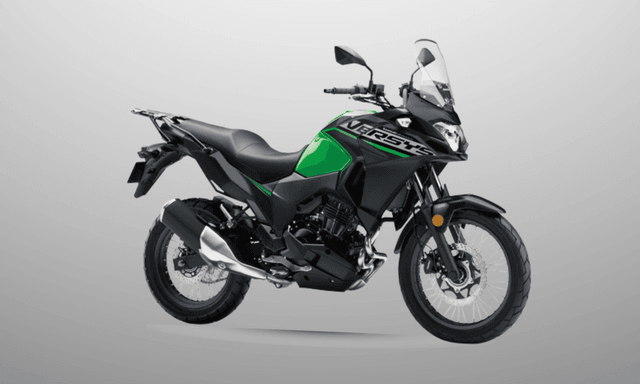Tata Harrier EV Off-Road Experience: How Capable Is Tata’s AWD Electric SUV?

- The Harrier EV comes with the option for a dual-motor setup
- Along with AWD you also get 6 terrain modes and off-road assist mode
- The Harrier EV is quite capable off-road
The newly launched Tata Harrier EV brings in a lot of first-time features - not just to the segment, but also to Tata’s vehicle line-up. But more importantly, it’s the first Tata vehicle in nearly 5 years to get an all-wheel drive (AWD) system. So, when the company invited us to test the Harrier EV’s off-road prowess, I was quite excited to see how capable the electric SUV is really.
But before we start, let me tell you, this is not our first drive review. The event was simply an opportunity to witness the off-roading capabilities of the Harrier EV and let me tell you I was quite surprised. You see, whenever brands invite us for an off-road experience, in most cases the off-road course is relatively simple, and not much of a challenge - neither for us nor the vehicle. However, the course Tata had designed for the Harrier EV was properly intense and challenging. Especially for an off-road novice like me.
Now, the Harrier EV we drive was the QWD option with the dual-motor setup - with a 156 bhp motor attached to the front axle and a 235 bhp motor to the rear axle. And the combined torque from the motors is a meaty 504 Nm. In addition to that, the SUV also comes with 6 different terrain modes and an off-road assist mode as well. It was during the first off-road obstacle that we got to test both.
Also Read: Tata Harrier EV: 10 Features That Are First For A Tata
I started off easy with the rock bed; the rock crawl terrain mode was activated, and the off-road assist mode was switched on. Then all I needed to do was put the SUV on drive and just control the steering. The SUV automatically crawls on the rocky surface offering the right amount of power and torque needed, making it an effortless pursuit. I experienced the same level of ease while crossing an extremely slushy mud pit as well. The only difference, the terrain mode was set at mud and ruts.
The Harrier EV also surprised me on the axle twister, and obstacle designed to see the level of articulation you can achieve. The terrain mode was still set on rock crawl, but here I had to manually accelerate and steer the vehicle. Here the traction control system is what plays a big role, and it did it quite effortlessly. The system was able to perfectly gauge which wheel was in contact with the surface and which wheel was not and accordingly sent power to the former to cross the obstacle.
Also Read: Tata Harrier EV Top Speed, Kerb Weight Revealed
I also got to gauge the SUV’s stability and control on the side incline and negative incline obstacles. In either case, the SUV was driven at a very steep angle, but it showed no signs of rollover or losing stability. But the real test of power and control was seen in the gradability tests where the Harrier EV was able to effortlessly climb at a 34-degree angle while descending at a 35-degree angle.
Now the Harrier EV comes with a 75 kWh battery pack underneath the body and despite that it has a ground clearance of 205 mm. While it might not seem very impressive, in applications it is quite useful. The SUV has an approach angle of 25.3 degrees, a departure angle of 26.4 degrees and a break-over angle of 16.6 degrees. What this means is that even with a wheelbase of 4607 mm, the Harrier EV can handle not just bumps and large speed breakers but huge camel humps that one might experience on off-road terrains.
The final test was the stair climb where I had driven the Harrier up a long flight of stairs, took a left-hand turn onto a platform and then another turn to come down a steep decline. These tests not only allow us to test the Harrier EV’s strong torque but also the traction control system's alertness, the turning radius, and the hill descent control system in action.
Now, in a nutshell, the short time I spent with the Harrier EV off-road has cleared one thing for me. The electric SUV is powerful and capable enough to handle going off-roading, well at least mild off-roading, after all, it is an all-wheel-drive system and not an outright 4x4. But the big question is - will old-school off-roaders like it? I don’t think they will. For them, the feel of a gas-guzzling off-road SUV with the mechanical 4x4 system will always be unmatched.
So, who is it for? Well, it is for those who mostly spend their week in the urban setting but like some light adventure on the weekends. Those who are interested in off-roading but lack the skillset to go all out, are looking for something that is not just capable of handling bad terrain, but also comfortable and convenient. All that said, I will only be able to give a proper opinion about the Harrier EV once I get to drive it, and our first drive review will go live in July 2025. So, keep watching this space.
Trending News
 1 min readTriumph Tracker 400: In Pictures
1 min readTriumph Tracker 400: In Pictures 1 min readTriumph Tracker 400 Unveiled in UK
1 min readTriumph Tracker 400 Unveiled in UK
Latest News
 Janak Sorap | Dec 17, 2025Triumph Tracker 400: In PicturesTriumph has unveiled the new Tracker 400 based on the Speed 400. Here’s a quick look at the motorcycle in pictures.1 min read
Janak Sorap | Dec 17, 2025Triumph Tracker 400: In PicturesTriumph has unveiled the new Tracker 400 based on the Speed 400. Here’s a quick look at the motorcycle in pictures.1 min read Jaiveer Mehra | Dec 17, 2025Tata Sierra Smart Plus Revealed In Official Pictures: What Do You Get For Rs 11.49 Lakh?While nearly everyone has seen the Sierra in pictures and many in person at dealerships, you’ll likely only have seen the top models. But what is the base variant like?2 mins read
Jaiveer Mehra | Dec 17, 2025Tata Sierra Smart Plus Revealed In Official Pictures: What Do You Get For Rs 11.49 Lakh?While nearly everyone has seen the Sierra in pictures and many in person at dealerships, you’ll likely only have seen the top models. But what is the base variant like?2 mins read car&bike Team | Dec 17, 20252025 Ducati Panigale V2, Streetfighter V2 Recalled In The USThe recall states that two ABS fuses may have been inadvertently fitted in the wrong positions during wiring assembly and could increase the risk of a crash.3 mins read
car&bike Team | Dec 17, 20252025 Ducati Panigale V2, Streetfighter V2 Recalled In The USThe recall states that two ABS fuses may have been inadvertently fitted in the wrong positions during wiring assembly and could increase the risk of a crash.3 mins read Jafar Rizvi | Dec 17, 2025Updated Bajaj Pulsar 220F Does Not Get Dual-Channel ABS; Company Issues ClarificationBajaj Auto has confirmed that the updated Pulsar 220F does not feature dual-channel ABS, contradicting earlier reports.1 min read
Jafar Rizvi | Dec 17, 2025Updated Bajaj Pulsar 220F Does Not Get Dual-Channel ABS; Company Issues ClarificationBajaj Auto has confirmed that the updated Pulsar 220F does not feature dual-channel ABS, contradicting earlier reports.1 min read Janak Sorap | Dec 16, 2025Triumph Tracker 400 Unveiled in UKBased on the Speed 400’s platform with the tune from the Thruxton 400.1 min read
Janak Sorap | Dec 16, 2025Triumph Tracker 400 Unveiled in UKBased on the Speed 400’s platform with the tune from the Thruxton 400.1 min read car&bike Team | Dec 16, 2025Kawasaki Versys-X 300 Offered With Rs 25,000 DiscountAfter the discount, the entry-level Kawasaki Adventurer tourer is priced at Rs 3.24 lakh (ex-showroom).3 mins read
car&bike Team | Dec 16, 2025Kawasaki Versys-X 300 Offered With Rs 25,000 DiscountAfter the discount, the entry-level Kawasaki Adventurer tourer is priced at Rs 3.24 lakh (ex-showroom).3 mins read
 Janak Sorap | Dec 11, 2025Harley-Davidson X440 T First Ride Review: Smarter and SharperHarley-Davidson has taken the X440 and given it a more focused and engaging twist. The result is the X440 T—essentially the same platform but updated in areas that give the motorcycle more appeal and riders more thrill.5 mins read
Janak Sorap | Dec 11, 2025Harley-Davidson X440 T First Ride Review: Smarter and SharperHarley-Davidson has taken the X440 and given it a more focused and engaging twist. The result is the X440 T—essentially the same platform but updated in areas that give the motorcycle more appeal and riders more thrill.5 mins read Shams Raza Naqvi | Dec 10, 20252025 Mini Cooper Convertible Review: More Colour On Indian RoadsThe updated Mini Cooper Convertible is set to be launched in the Indian market in the next few days. We drive it around Jaisalmer for a quick review.1 min read
Shams Raza Naqvi | Dec 10, 20252025 Mini Cooper Convertible Review: More Colour On Indian RoadsThe updated Mini Cooper Convertible is set to be launched in the Indian market in the next few days. We drive it around Jaisalmer for a quick review.1 min read Bilal Firfiray | Dec 8, 2025Tata Sierra Review: India’s New Favourite?Marking its return after a few decades, the reborn Sierra has made everyone sit up and take notice. But is it worth the hype?10 mins read
Bilal Firfiray | Dec 8, 2025Tata Sierra Review: India’s New Favourite?Marking its return after a few decades, the reborn Sierra has made everyone sit up and take notice. But is it worth the hype?10 mins read Girish Karkera | Dec 4, 20252026 Honda Prelude First Drive: Domesticated Civic Type RA sporty-looking coupe built to give customers a taste of performance but not at the expense of everyday practicality.5 mins read
Girish Karkera | Dec 4, 20252026 Honda Prelude First Drive: Domesticated Civic Type RA sporty-looking coupe built to give customers a taste of performance but not at the expense of everyday practicality.5 mins read Seshan Vijayraghvan | Nov 29, 2025Mahindra XEV 9S First Drive Review: Big Electric SUV, Bigger ExpectationsThe XEV 9S lands at a time when the EV crowd is growing fast. It’s a big, born-electric, three-row SUV that starts under 20 lakh. It sits close to the XUV700 in size, but the brief is very different. Here’s what it’s like on the road.11 mins read
Seshan Vijayraghvan | Nov 29, 2025Mahindra XEV 9S First Drive Review: Big Electric SUV, Bigger ExpectationsThe XEV 9S lands at a time when the EV crowd is growing fast. It’s a big, born-electric, three-row SUV that starts under 20 lakh. It sits close to the XUV700 in size, but the brief is very different. Here’s what it’s like on the road.11 mins read
















































































































































